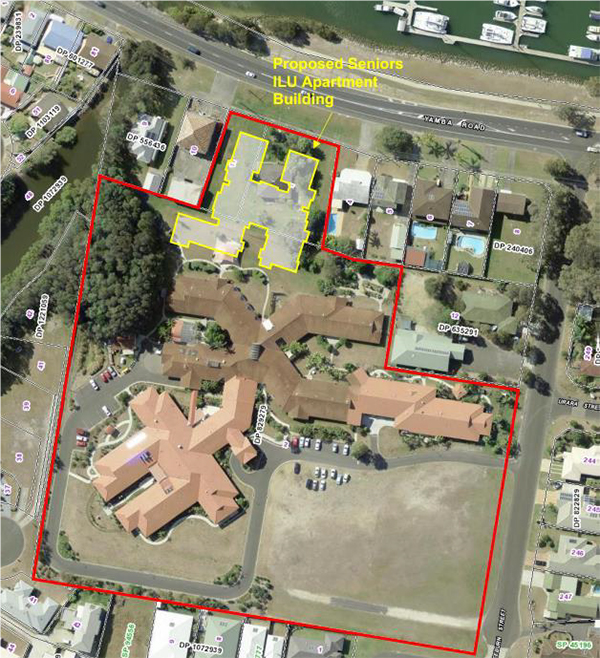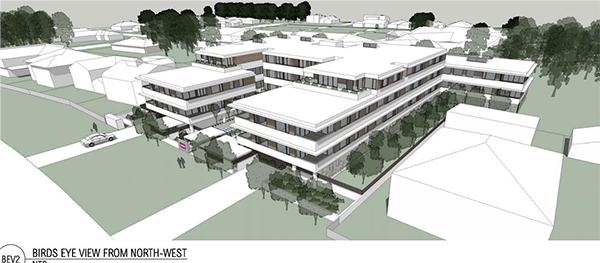Geoff Helisma|
The report to last week’s Clarence Valley Council (CVC) meeting advised councillors that one of the developer’s justifications for approving the construction of a four-storey building on Yamba Road was that it “will not create an undesirable precedent or cumulative effect” for future development proposals in Yamba.
Councillors Peter Ellem and Karen Toms disagreed.
Councillor Toms described the proposed height variations, which exceed the maximum heights in the Seniors Living State Environmental Planning Policy (SEPP) and the Clarence Valley local environment plan (CVLEP), as “the biggest I can remember”, and that approving four storeys would set a “precedent”.
She held privacy concerns for a neighbour, who would suffer “a large loss of amenity”.
Councillor Ellem reflected on a 2007 decision, by then planning minister Frank Sartor, to approve four-storey buildings at the Blue Dolphin Holiday Resort.
“I editorialised against it [when the editor of DEX] … I’d be a bit of a hypocrite if I supported this one,” he said.
“At that height, it will set a precedent in Yamba … and have severe impacts on the neighbours.”
The CVLEP prescribes a maximum height of nine metres and the seniors SEPP prescribes a maximum height of eight metres.
Fifty percent of the building will stand 11.7 metres high, not including an extra metre for the lift and skylights.
The LEP says the nine metre maximum is meant to “maintain the low scale character of towns and villages in the Clarence Valley
[and]
protect the amenity of neighbouring properties…”.
Staff write in the report that “the main reason for the height variation appears to be maximising the unit yield by allowing the apartments on the first storey to be above the habitable floor area required for flood affected lots”.
In other words, the first floor is car parking.
After considering 12 of the applicant’s justifications, for allowing variations to the SEPP, LEP and development control plan (DCP), staff only highlighted one: “The proposal is consistent with the objectives of Clause 4.3 of the CVLEP.”
Staff noted that the height variation, “when considered against the first of the objectives of 4.3 of the CVLEP, would generally be inconsistent with maintaining the low scale character of towns and villages in the Clarence Valley”.
Quoting the applicant’s ‘design verification statement’, which “likens the building to that of low-density buildings in coastal towns … [and advocates the] use of … horizontal emphasis and light and dark tones to additionally lower the visual scale of the buildings”, staff concluded: “In this respect the development is one that will dominate the streetscape in this location, though not be imposing, due to the overall design of the building [and] recessing or stepping of the upper level to around 17 metres from Yamba Road, [with] generous setbacks and provision of landscaping, which achieves reduced bulk and scale visual impacts.”
On amenity and overshadowing, staff wrote: “Overall the proposal is considered to be consistent with the setback objectives of the DCP.”
Speaking in favour of the proposal, Cr Andrew Baker said the proposal had “architectural merit” and that the applicant had “done a fantastic job to get the best use of this accommodation in a community that is obviously calling out for these facilities”.
He said it wasn’t a precedent because one had already been set – redevelopment of the Surf Motel (0.27metres above max height) and redevelopment of the Sisters of Mercy convent, stepped down the steep slope of Coldstream Street.
“Each development application should have the opportunity to stand on its own two feet; this is all merit,” he said
Councillor Arthur Lysaght spoke in favour.
“Caroona ought to be congratulated,” he said, “not have barriers put in their way.”
He said it would provide accommodation for a “lot of people in the lower river who want to stay in an area where they want to live”.
Councillor Grag Clancy, who said he was “not against the proposal, in principle”, spoke against; he focused on the building’s height.
“I could live with something less than a one metre, but 2.7 metres in one category [LEP] and 3.7 in another [Seniors Living SEP]? … high buildings are not suitable for seniors,” he said.
No one else spoke on the matter; councillors Lysaught, Williamson, Baker, Simmons and Kingsley approved the proposal; councillors Ellem, Toms, Novak and Clancy were opposed.

